
English Apples - Apple Breeding
It can be interesting to cross apple varieties. A number of well-known commercial apples have been produced in this way. Hugh Ermen is probably the best-known English apple breeder, and he produced 'Red Devil' and a number of other excellent varieties.
There are currently apple breeding programmes in Switzerland, New Zealand and South Africa to develop new commercial types - especially redfleshed.
To cross two apple varieties:
1. Assemble an Apple Breeder's Kit: a fine comb, a glass rod, and some modified scissors, with a small circular notch cut out of the blade.
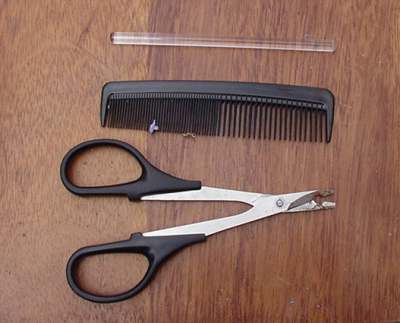
2. Collect the pollen from one of your chosen varieties, as shown. Keep for a day or two in an open container until it goes dry and dusty. Bottle and label it. (it can be kept viable in the fridge for up to 3 years if thoroughly dried with silica gel or similar).
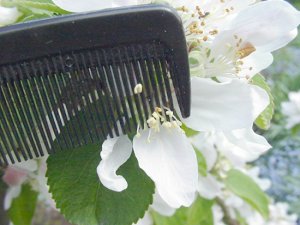
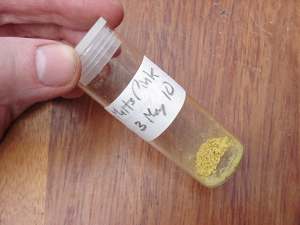
3. Choose the variety to be pollinated with your named pollen. Using your modified scissors, emasculate the unpollinated flower whilst at the 'balloon' stage. Hold the stem, and grip the calyx with the scissors, then pull gently.
The technique is shown in the following pictures. Emasculation removes the stamens. It also removes the calyx, which will be missing from any fruit which develop; this is how you recognise your hand pollinated fruits.
Some types are easier to do than others. Small apples are difficult because the stems break easily.
I generally do about three flowers to a cluster and then cut the others off.
Here's a cluster suitable for pollination.
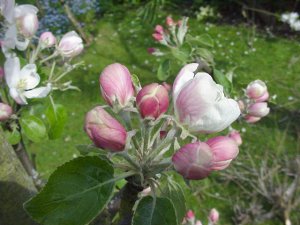
Emasculate three of them. The other flowers should be cut off.
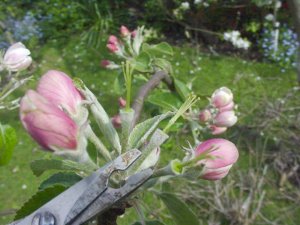
4. Dip the glass rod in the pollen dust and gently apply it to the anthers of the emasculated flowers.
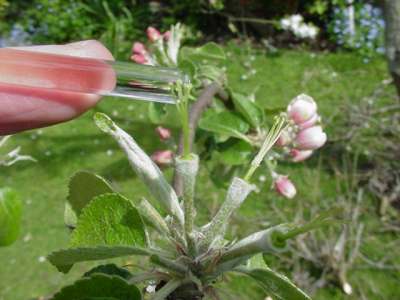
5. Possibly most important of all - write down what has been crossed with what.
6. In the autumn - look for fruits with no calyx. Pick the ones you want; remove the seeds. Keep them in the fridge for 2-3 months.
7. Later in the winter, or early spring - sow the seeds in compost. Do not allow fungus to develop (use cheshunt compound or similar). Ruthlessly discard any seedlings which are diseased or weak.
8. Grow the healthy seedlings until big enough to graft onto MM106 or other small rootstock to induce early fruiting.
LATER PICTURES
THREE WEEKS AFTER POLLINATION
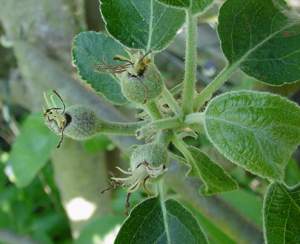
Above: D'Arcy Spice, hand pollinated with George's Red.
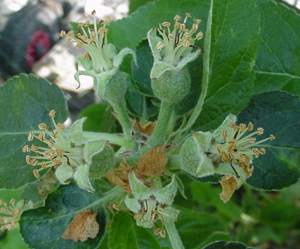
Above: D'Arcy Spice, pollinated by bees, for comparison.
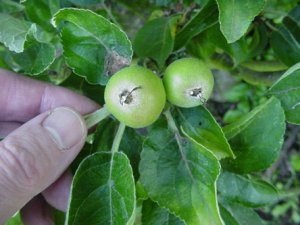
Above: D'Arcy Spice, hand pollinated, same cluster as above, mid-June 2010.
FRUITING SEASON
Now we move forward to late September, when some of the pollinated fruit are ready for picking. Here we have Laxton's Fortune, pollinated by Almata, an American red-fleshed variety.
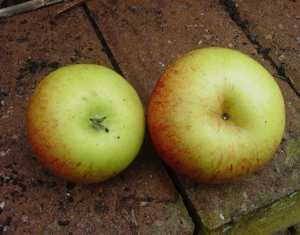
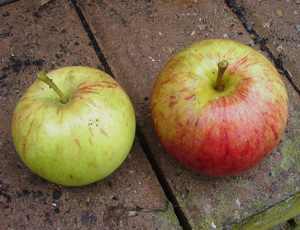 ....
....
Above: Laxton's Fortune x Almata.
The apple on the LEFT is pollinated in the normal way (by bees); the one on the right was pollinated by hand and is lacking a calyx, so looks rather odd. It's this one which will contain the interesting seeds.
The second picture shows the other end of the same two apples.
Next is Ribston, pollinated with pollen from Mott's Pink, another American red-fleshed apple with a beautiful delicate flavour. A bee-pollinated apple of the same variety is shown on the left, for comparison.
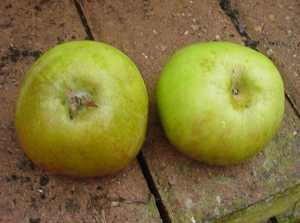 ....
....
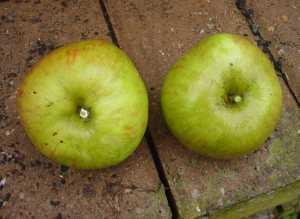 ....
....
Ribston's Pippin x Mott's Pink
I carried out this cross because Ribston is (debateably) the best-flavoured English apple, and Mott's Pink is a favourite red-fleshed apple.
EXTRACTING THE SEEDS
I do this in early to mid January and send the seeds off to enthusiastic growers. The first one shows an apple resulting from pollinating Laxton blossom with Almata.....
Click on the pictures for the detail.
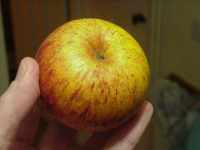
Extracting the seeds - this apple had six plump pips:
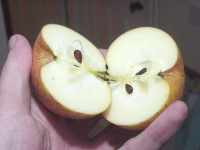 .....
.....
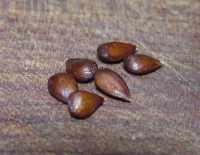 .....
.....
UPDATE, MARCH 2011
Seedlings are starting to germinate ... here are the first pictures:
 .....
.....
Laxton x Almata; two seedlings red stemmed, one green stemmed. Germination 3/3.
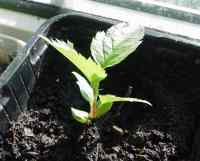 .....
.....
Ribston's Pippin (triploid) x Mott's Pink. Appears to be more or less green stemmed. Germination 1/4.
Other crosses - Germination:
D'Arcy Spice x Mott's Pink: 7/16
Whitwick Pippin x George's Red 1/5
Croft Late x George's Red 0/5
This page is getting too long so we'll start a new page .
ND / Diversity website